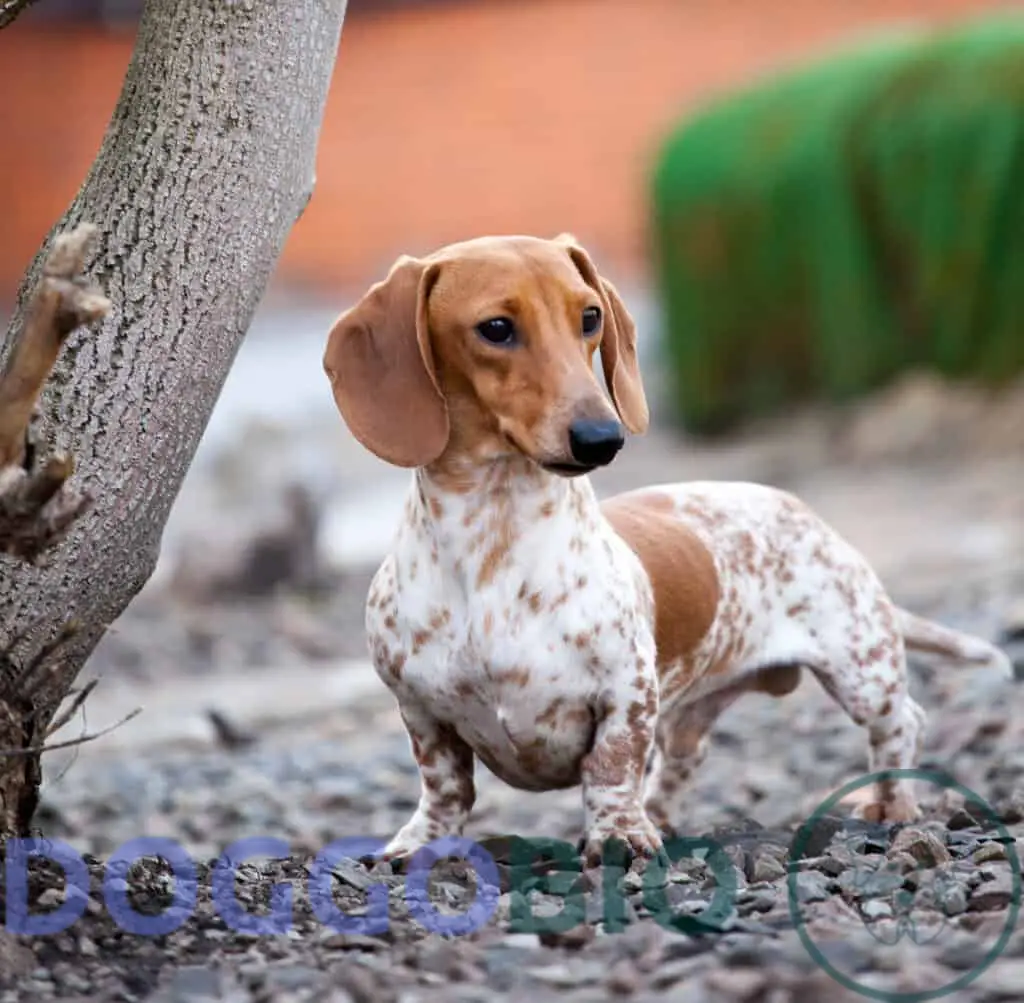Welcome to the enchanting world of brindle Dachshunds, where the elegance of the Dachshund breed meets the mesmerizing allure of brindle coat patterns. These distinctive canine companions captivate hearts with their unique charisma, intelligence, and striking coloration.
In this exploration, we’ll delve into the captivating characteristics that set brindle Dachshunds apart, from their rich history to their charming personalities. Whether you’re a devoted Dachshund enthusiast or a newcomer to the world of dog breeds, join us as we unravel the captivating tale of these delightful brindle-patterned canines.
A Brief Overview of Brindle Dachshunds
| Feature | Details |
| Appearance | Short, smooth hair or long, wiry hair in a brindle pattern with stripes of brown, red, and black. Can also have brindle patches with solid black or tan areas. |
| Size | * Standard: 16-23 lbs, 8-9 inches tall at the shoulder. * Miniature: 11-14 lbs, 5-6 inches tall at the shoulder. * Kaninchen: 8-11 lbs, 5-6 inches tall at the shoulder. |
| Temperament | Lively, playful, and affectionate. Can be stubborn and independent, but with proper training and socialization can be loyal and well-behaved companions. |
| Energy Level | Moderate to high. Requires daily walks and playtime. |
| Lifespan | 12-16 years |
| Health | Generally healthy breed, but prone to certain conditions like intervertebral disc disease, back problems, and eye problems. |
| Origin | Germany |
What Are Brindle Dachshunds?

Brindle Dachshunds are a testament to the wonders of genetics. While they are not a separate breed, their coat pattern sets them apart.
“Brindle” refers to the dark stripes that overlay a lighter base coat. This pattern can manifest in shades, from light to dark, and appear on any base color.
The brindle pattern is not exclusive to Dachshunds and can be found in other dog breeds. However, in Dachshunds, it’s a sight to behold. The contrast between the dark stripes and the base color gives them a regal appearance.
How Do You Get a Brindle Dachshund?
The brindle pattern in Dachshunds is due to a specific gene. When two Dachshunds mate, if one of them carries the brindle gene, there’s a chance their offspring will exhibit the brindle pattern. It’s a dominant trait, which means that even if only one parent has the gene, the puppies can still inherit the pattern.
Breeders who understand these genetics can breed for this pattern, but nature always has the final say, making each Brindle Dachshund unique.
For those interested in acquiring a Brindle Dachshund, it’s essential to research and approach breeders who have experience with this specific coat pattern. The genetics behind the brindle pattern is complex, and understanding it can provide insights into the world of dog breeding.
Do Dachshunds Come Only In Brindle?
Dachshunds are a diverse breed when it comes to coat patterns and colors. While the brindle pattern is enchanting, it’s just one of the many patterns:
1.Dapple Dachshund

Dapple Dachshunds have a merle pattern, characterized by lighter or darker spots on their coat. It’s a beautiful pattern that gives them a speckled appearance.
2.Double Dapple Dachshund

This results from breeding two dapple Dachshunds. They have unique patterns, but this breeding can sometimes lead to health issues.
3.Piebald Dachshund

These Dachshunds have a primarily white coat with colored patches. The patches can be of any color, from black to brown or even gray.
4.Sable Dachshund

They have a two-toned coat. The hair is light at the base and dark at the tips, giving them a shaded appearance.
5.Brindle-Piebald Dachshund

A rare combination of the brindle and piebald patterns. These dogs have a striped brindle pattern along with white patches. This combination is rare but is a sight to behold.
History of Brindle Dachshunds
The Dachshund breed has deep roots in Germany. Initially bred for hunting, these dogs were fearless and agile, perfect for chasing down prey. As the species evolved, so did their coat patterns. Though not as common as others, the brindle pattern has historical significance.
Ancient texts and paintings have depicted Dachshunds with striped patterns, indicating the presence of the brindle variation for centuries. Like other coat patterns, the brindle pattern emerged as breeders and nature worked together, leading to the diverse range of Dachshunds we see today.
Interesting Facts about Brindle Dachshunds
Brindle Dachshunds are a treasure trove of interesting facts. Here are some tidbits:
- The brindle pattern is not exclusive to Dachshunds. It’s found in various dog breeds.
- In Dachshunds, the brindle pattern can appear over any base color, making each Brindle Dachshund unique.
- The pattern results from a dominant gene, meaning the offspring can still be brindle even if only one parent carries the gene.
- While major kennel clubs recognize them, they are often mistaken for other patterns by the untrained eye.
- Brindle Dachshunds have been depicted in art and literature, showcasing their historical significance. The pattern’s genetics and visual appeal have made the Brindle Dachshund a favorite among breeders and enthusiasts.
What does a brindle Dachshund look like?
A Brindle Dachshund is a visual delight. Their unique coat pattern sets them apart from other Dachshunds.

Size, height, and Weight
- A standard Dachshund can weigh up to 30 pounds and stand about 8 to 9 inches tall.
- Miniature Dachshunds are more minor, weighing less than 11 pounds.
The brindle pattern is evident and adds to their charm regardless of size. The breed’s standard has evolved over the years, but the brindle pattern remains a constant, adding depth and character to the species.
Coat colors and Types
The brindle pattern overlays the base coat, which can be of any color. From red to cream, chocolate, black, and tan, the brindle stripes add depth and character to their coat. This pattern can appear on smooth, long-haired, or wire-haired Dachshunds, making each one unique.
Temperament and Personality
Like their counterparts, Brindle Dachshunds are known for their spunky and spirited nature. They are curious and always ready for an adventure. Their hunting origins are evident in their behavior; they love to chase and play.
However, they are stubborn at times. Training them requires patience. Despite their small size, they are brave and can protect their family. Their loyalty and affection make them excellent companions, and their playful nature ensures there’s never a dull moment with them around.
Training and Exercise Requirements
Dachshunds are intelligent dogs. They pick up orders quickly but can be a tad stubborn. Consistent training methods work best with them. Positive reinforcement and treats can go a long way in training a Dachshund.
Exercise is crucial. Regular walks and play sessions are necessary to keep them fit and prevent obesity, a common issue in the breed. Due to their hunting origins, they have a lot of energy to burn. Engaging them in interactive games and providing them with toys can help channel their energy positively.
Grooming and Cleaning
Grooming a Brindle Dachshund depends on their coat type.
- Smooth-coated Dachshunds are low maintenance, requiring occasional brushing.
- Long-haired ones need regular grooming to prevent matting
- While wire-haired Dachshunds benefit from periodic hand-stripping.
Bathing should be done as necessary, ensuring their coat remains clean and debris-free. Regular ear cleaning and nail trimming are essential to keep them in top shape.
Food and Diet
Dachshunds have a hearty appetite. Feeding them a balanced diet is crucial for their overall health. Portion control is essential as they can gain Weight quickly. Freshwater, lean proteins, and vegetables should be a part of their diet.
Monitoring their calorie intake and ensuring they get the necessary nutrients is also essential. Supplements can be added as per a vet’s recommendation. Their dietary needs are unique, and understanding them can provide a healthy and well-fed dog.
Life Expectancy and Common Health Issues
With their unique physique and spirited nature, Dachshunds have a life expectancy of 12 to 16 years. This lifespan, however, can be influenced by various factors, including genetics, diet, exercise, and overall care.
While they are generally robust and lively dogs, Brindle Dachshunds, like other variations of the breed, are susceptible to specific health issues.

1.Hip Dysplasia
This is a genetic condition where the hip joint doesn’t develop correctly, leading to arthritis and pain. Regular check-ups and maintaining an optimal weight can help manage this condition.
2.Intervertebral Disc Disease (IVDD)
Due to their elongated spine, Dachshunds are prone to this condition. It involves the disc in the spine bulging or bursting, causing pain or even paralysis. Early detection and treatment are crucial.
3.Dwarfism
While Dachshunds are naturally small, some may suffer from extreme dwarfism, leading to additional health challenges.
4.Obesity
Their love for food and a tendency to be less active, especially in older age, can lead to obesity. This can further exacerbate conditions like hip dysplasia and IVDD.
5.Retinal Atrophy
This is a degenerative eye disease that can lead to blindness. Regular eye check-ups can help in early detection.
6.Muscular Dystrophy
A rare condition in Dachshunds, it’s a degenerative muscle disorder that can affect their mobility.
7.Osteoporosis
Older Dachshunds can suffer from weakening bones like humans, making them more prone to fractures.
8.Epilepsy
Some Dachshunds may suffer from seizures. While it can be alarming to witness, it can be managed with proper medication and care.
9.Patellar Luxation
This involves the dislocation of the kneecap, which can be painful and may require surgery.
10.Gastric Dilatation Volvulus
Commonly known as bloat, it’s a life-threatening condition where the stomach fills with gas and twists. Immediate medical attention is required.
How much are brindle Dachshunds?
The cost of a Brindle Dachshund can vary based on various factors. Their unique coat pattern, lineage, and the breeder’s reputation play a role in determining their price. On average, they can range from $500 to $1500, with some going for even higher prices based on their pedigree.
Researching and approaching reputable breeders is essential to ensure you get a healthy and well-bred Brindle Dachshund. The breed’s popularity, combined with the unique brindle pattern, can influence its price.
How Can I Find a Brindle Dachshund For Sale?
Finding a Brindle Dachshund requires research. It’s essential to approach reputable breeders who prioritize the health and well-being of the dogs.
Breed clubs, online forums, and rescue organizations can also provide leads. Adopting a Brindle Dachshund from a rescue can be a rewarding experience, giving a dog a second chance at a loving home.
Finding a Brindle Dachshund can be intricate, but finding the perfect companion with the right resources and patience is possible.
Is this breed the Right Dog for You?
Brindle Dachshunds are not just about their coat pattern. They are lively, affectionate, and can be a tad naughty.
Before bringing one home, potential owners should consider their exercise, training, and grooming needs. Understanding the breed’s requirements and characteristics ensures a harmonious relationship between the owner and the dog.
Their unique temperament and striking appearance make them a sought-after breed. However, they also come with challenges, and being informed can ensure a happy and fulfilling relationship.
List of dogs that are similar to Brindle Dachshund
Frequently Asked Questions
How many pups do brindle Dachshunds have?
Typically, a Dachshund can give birth to 4 to 8 puppies. However, this number can vary based on the dog’s health, age, and genetics.
Can Dachshunds be brindle?
Yes, Dachshunds can have a brindle coat pattern. This pattern consists of dark stripes over a lighter base color.
Are brindle Dachshunds dapple?
No, brindle and dapple are two distinct coat patterns. While brindle features stripes, dapple Dachshunds have a merle or speckled pattern.
Are Brindle Dachshunds rare?
While not the most common, brindle Dachshunds are not exceedingly rare. Their unique coat pattern, however, makes them stand out and highly sought after.
What is the rarest color in Dachshund?
The pure black Dachshund, without any tan or other color markings, is considered one of the rarest colors.
Does AKC recognize Brindle Dachshund?
Yes, the American Kennel Club (AKC) recognizes the brindle coat pattern in Dachshunds.
How Long Can a Brindle Dachshund Live?
Like other Dachshunds, Brindle Dachshunds have a life expectancy of 12 to 16 years, depending on their health and care.
Do brindle Dachshunds Shed A Lot?
Yes, moderately.
Dachshunds, including those with a brindle coat pattern, have a moderate shedding level. Their shedding frequency and amount can vary significantly based on their coat type.
Are brindle Dachshunds hypoallergenic?
No, regardless of their coat variation, such as brindle, Dachshunds are not considered hypoallergenic. Like many other breeds, they produce dander and shed, which can trigger allergies in sensitive individuals.
If someone is looking for hypoallergenic breeds, it’s essential to research and find species known explicitly for those characteristics.
Conclusion
Brindle Dachshunds are a testament to the beauty of genetics. Their unique coat pattern, combined with their spirited personality, makes them a favorite among dog enthusiasts.
Whether you’re considering bringing one home or just curious about the breed, it’s undeniable that Brindle Dachshunds are truly special. Their rich history and captivating appearance ensure that they remain a topic of interest for many.
The world of Brindle Dachshunds is vast and intriguing, and this article aims to provide a comprehensive overview of this unique variation.

Pingback: Isabella Dachshund: Embracing Exquisite Shades 2024
Pingback: Blue Merle Australian Shepherd: Detailed Insight 2024